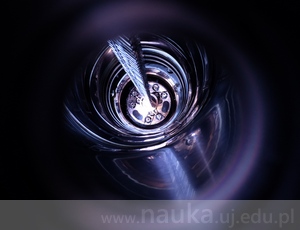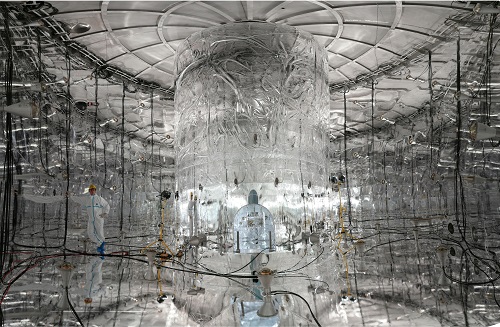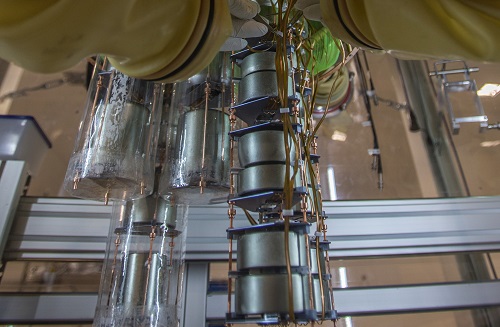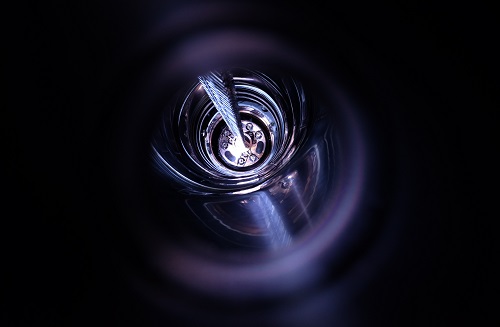
A group of JU researchers participates in a study which aims to answer the most basic questions of modern science. It can lead to the discovery of an all new particle – an achievement rivalling the registration of the Higgs boson.
Neutrinos are electrically neutral elementary particles, classified in the Standard Model. Since their interactions with matter are very weak, they are exceptionally difficult to detect; however, they play a key role in the thermonuclear fusion happening in solar core of the Sun and in supernovae eruptions. Additionally, they played an important part in the process of forming chemical elements during the Big Bang.
Why is there so much matter?

The latest issue of Nature features an article discussing the development in the search of neutrinoless double beta decay (0vββ) of 76Ge germanium isotope. The research is conducted by the GERDA team inside an underground laboratory in Gran Sasso, Italy. Several scientists from the JU Institute of Physics are the participants of this project: Prof. Marcin Wójcik, Dr Marcin Misiaszek, Dr Krzysztof Panas, Dr Krzysztof Pelczar, Dr Grzegorz Zuzel and Nikodem Frodyma.
The aim of the study is to answer one of the most fundamental questions of modern physics: what exactly are neutrinos? Can they determine the properties of matter and antimatter? A lot of physical theories that go beyond the Standard Model (BSM) assume that neutrinos are the particles responsible for the domination of matter over anti matter in the Universe (that is, if they’re their own anti-particles).
Every elementary particles has its own anti-particle counterpart. The particle and antiparticle have an identical mass, but opposite electrical charges. ‘When an elementary particle interacts with its antiparticle, they are annihilated – both disappear, and their combined energy is released in a different form. It is thought that just after the Big Bang, the Universe contained small, but equal amounts of matter and antimatter. Over time, they should have interacted with each other and systematically annihilate themselves, turning their mass into energy’, explained Prof. Marcin Wójcik. However, we can see that the Universe is made out of matter. How can we explain this?
Scientists theorise that during the very early stages of the formation of the Universe, both neutrinos and antineutrinos possessed their equally heavy counterparts, but the processes happening between various particles disturbed the symmetry, which led to there being more matter than antimatter. But all these processes would’ve had to happen in the first fractions of a second after the Big Bang.
The elusive ββ decay

Beta decay (ββ) is one of the types of radioactive decay. There’s a multitude of various radioactive elements in our environment, such as the omnipresent 40K potassium isotope with a half-life (the time required for a quantity to reduce to half its initial value, commonly abbreviated as t1⁄2) of 109 years, which is a natural component of normal potassium – a chemical element essential to the functioning of living cells. Another example would be 14C carbon (half-life: 103 years), used in various carbon dating techniques.
We currently know of 10 radioactive isotopes that undergo an extremely rare process of double beta decay (ββ). One of them is 76Ge germanium, with a half-life of 1021. The longer the half-life, the lesser probability there is of an isotope transforming into another isotope, which means it occurs much more rarely. ‘We’re talking about colossal numbers. The half-life of 76Ge is a trillion times longer than the age of the Earth. In spite of that, the GERDA array is able to detect it with ease, which points to its extreme sensitivity’, stressed Prof. Wójcik.
A discovery worthy of the Nobel Prize

Registering the neutrinoless double beta decay (0vββ) requires an exceptionally low – preferably nonexistent – background (background is the term referring to undesirable events, frequently indistinguishable from the ones that scientists actually want to examine; they form a ‘static’ of sorts). ‘GERDA is the first and only experiment dedicated to studying double beta decay in which we shouldn’t expect any background event. We’ve managed to achieve this by using an ultra-pure liquid argon as a very good passive shield and active veto as well as the excellent energy resolution of our germanium detectors’, said Dr Grzegorz Zuzel. These promising results are the fruit of the GERDA team’s innovative research methods and data analysis, such as experimental background reduction. The development of experimental methods conceived of during the GERDA experiment will be continued in the LEGEND project, which also features physicists from the JU Institute of Physics.
Detecting the neutrinoless double beta decay will be almost as important as discovering a new elementary particle. Such an achievement would be as great as the discovery of Higgs boson that happened in the recent years, which earned the discoverer the Nobel Prize. Proving that the 0vββ doesn’t exist would also be invaluable, since it would help determine the neutrino mass hierarchy, which form the basis for many theories of the Universe’s evolution.
The next meeting of all the participants of the experiment will be held at the JU Institute of Physics in June. During that meeting, new result of the research will be published – perhaps this time the scientists will have some answers.
Original text: www.nauka.uj.edu.pl





